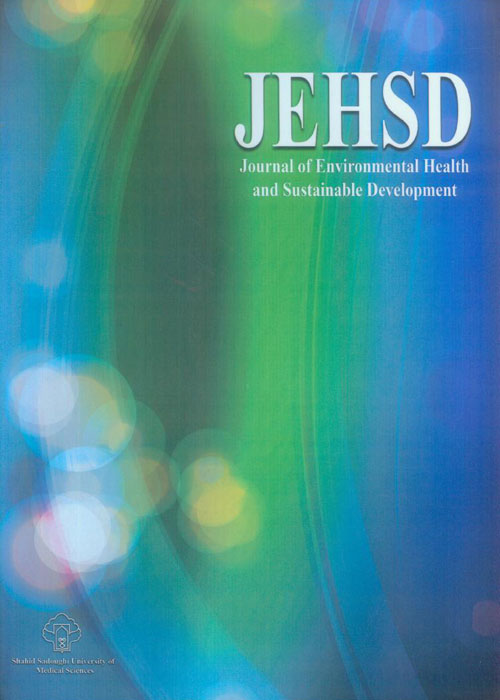فهرست مطالب

Journal of Environmental Health and Sustainable Development
Volume:1 Issue: 1, Jun 2016
- تاریخ انتشار: 1395/03/20
- تعداد عناوین: 6
-
Page 1IntroductionColloidal materials and suspended solids cause turbidity in water. To remove turbidity, clarification method is used that includes processes of coagulation, flocculation, and sedimentation. Due to the long duration of coagulation process, coagulant aids are applied. Despite the favorable efficiency of synthetic polyelectrolytes as a coagulant aid, due to their harmful effects on human health, in this process natural organic polymers are used instead.MethodsIn this research, the use of tragacanth as a natural organic coagulant aid instead of synthetic polymers in water turbidity removal along with alum and poly aluminum chloride is studied. To compare the experiments with natural conditions, Karun River water is analyzed. To complete these studies, the effects of several factors such as tragacanth concentration, the concentration of alum and poly aluminum chloride, and pH changes in average and low turbidity are investigated. Optimum pH for turbidity removal was determined by jar testing.ResultsThe results showed that the best pH to remove turbidity is 5.5 to 7, with the efficiency of 97.3%. At PH = 6 and at the concentration of 30 mg/L, poly ammonium chloride has maximum efficiency (90%). Using tragacanthat concentrations of 1 and 4 mg/L along with alum at a concentration of 40 mg/L leads to turbidity removal of 81.75%.ConclusionUsing 2 and 4 mg/L of tragacanth, a significant removal efficiency is achieved in low and average turbidity.pH=7 leads to the most efficient use of tragacanth coagulant aid.Keywords: poly aluminum chloride, alum, tragacanth, coagulant aid, karun river
-
Page 11IntroductionPrimary schools are children's first social environments. Other people's attitudes towards environmental hazards play a key role in developing children's personality. This study aimed to identify and assess the environmental risks (such as emission of pollutants into the air, discharge of pollutants into water and soil, energy consumption, etc.) in Shohadaye Kork girl primary school in Kashan, Iran, and investigating the role of environmental education in the promotion of student's environmental knowledge.MethodsIn this quasi-experimental study, at first environmental hazards were identified by a checklist through field visits and observing student's activities, and then they were assessed through Preliminary Hazard Analysis (PHA) method. After that, the Risk Assessment Code 1 (RAC1) was calculated. By Considering the hazards involved, environmental education was presented and then RAC2 was calculated. Environmental awareness of 172 students was investigated by a questionnaire. SPSS v.19 was used for statistical analysis.Results26 environmental hazards were identified, including 22 acceptable and 4 unacceptable (critical) hazards; 21 could be directly resolved by proper education. The mean scores of student's environmental tests were respectively 5 and 18.21 before and after the education. After taking control of measures all hazards were placed within the acceptable range.ConclusionsSchools environmental management plays so important role in preparing students for environmental education that the results of this study showed a significant relationship between education and promotion of student's environmental awareness.Keywords: Environmental Education, Risk Assessment, Primary Students, Kashan City
-
Page 22IntroductionThe objective of this study was, wastewater quality investigation and removal efficiency of contaminants from the wastewater tile factory by using coagulants includes ferric chloride, ferric sulfate and ferrous, aluminum sulfate and poly aluminum chloride in order to reuse it in the processing line.MethodsThis is an applied study. With regard to shiftwork schedules of the factory, the composite samples of wasrewater in production line was obtained. Firstly, based on standard methods wastewater parameters were measured . In the next step by using the jar- test the effect of changing coagulants dosing(0.15, 0.2, 0.25, 0.3, 0.35g/L) and pH values (7,9,11) on the removal parameters of turbidity, EC, TSS, TS and COD was investigated. Finaly the effective dose and optimal pH were selected and the best coagulant was determined.ResultsThe optimum PH of ferric chloride, ferric sulfate and ferrous that optimum was 11as well as it was 7 for aluminum sulfate and poly aluminum chloride. The optimum concentration of iron-based coagulants and aluminum-based coagulants was 0.3 g/L and 0.25 g/L, respectively. Poly aluminum chloride with removal of 99.92% , 99.94%, 89.8 and 75% has the best removal efficiency for turbidity, TSS, TS and COD, respectively. In addition, in a lower dose aluminum sulfate, ferrous sulfate, ferric chloride and ferric sulfate had the best removal efficiency.ConclusionAmong the five studied coagulants, poly aluminum chloride, aluminum sulfate and ferrous sulfate had the most efficiency, respectively. Due to the high cost of aluminum chloride, it needs more accuracy to select the most suitable coagulant.Keywords: Coagulant, Wastewater treatment, Tile industry, Turbidity, COD
-
Page 33IntroductionArsenic is known as a carcinogenic compound in drinking water . It can cause acute and chronic effects on human health. In this study, the effect of polyamidoamine dendrimer generation 3(PAMAM G3) as adsorbents for removal of arsenic (V) from aqueous solutions was evaluated.
MethodsAdsorption experiment was studied in batch system and the effect of different variables like pH, contact time, concentrations of arsenic and adsorbent dosage on adsorption was studied. Therefore, absorption kinetics and equilibrium isotherms were determined.
ResultsThe results showed that adsorption process is affected by some parameters such as initial concentration, adsorbent and contact time. The three models of isotherm included Langmuir, Freundlich and Dubinin- Radeshkuvich were studied that Freundlich and Langmuir isotherms were more compliant with results.
ConclusionAccording to results, can be concluded that adsorption with dendrimer is an appropriate method with high efficiency for removal arsenic from aqueous solutions.Keywords: arsenic, dendrimer, adsorption, aqueous solution -
Page 43IntroductionThe present study aimed to investigate the microbial quality of the produced vermicomposts and compare them with the existing standards.MethodsThis experimental study was conducted as a pilot-scale one, in the laboratory school. some perishable domestic waste were mixed in a reactor, including food waste, vegetables and fruits, cow manure and sludge of wastewater treatment plant. Tests to determine the microbial quality of the product were carried out at an early stage, during the process of production and on the final product. These tests included determining the probable number of fecal coliform bacteria and parasite eggs.ResultsAccording to the results of this study, a significant decrease was observed in the number of fecal coliforms in Sludge manure and domestic waste, as the number of fecal coliforms reduced from 5000000 (MPN / g), in the raw sample to 1500 (MPN / g), eight weeks after the outset. Moreover, according to the obtained results, the mixture of manure, sludge, and domestic waste had some parasite eggs (20 number /gr) in the raw samples. This amount was fully removed by the process of vermicomposting, during the third week.ConclusionFindings revealed that the earthworms have a high capability to reduce the pathogens without increasing in temperature, however, in order to standardize the number of coliforms (compost class A), the vermicomposting of the mixture of cow manure, domestic waste, and sludge of wastewater treatment plant is not appropriate.Keywords: Cow Manure, Domestic waste, Pathogens, Sludge, Vermicompost, Parasite eggs
-
Page 51IntroductionAntibiotics as a type of pharmaceutical compounds are widely used in modern medicine and veterinary industries. They enter the environment in different ways, including agricultural runoff, direct discharge of urban wastewater treatment or human waste, direct disposal of medical, veterinary industrial waste and etc. Antibiotics have been able to influence the microbial population. Their continuous presence in the environment can lead to bacterial resistance and in recent years the issue has caused serious concerns in the scientific community.MethodsUnfortunately, In spite of the extensive investigations, there is still a considerable lack of integrated and classified information to assess the environmental risks of antibiotics. Therefore, in the current study, the removal of these compounds from aqueous solutions was studied. This study was carried out on the basis of surveys accomplished in recent decades and also the ones published in databases such as Google Scholar, PubMed, Elsevier, Scopus, Springer, Magiran and SID using Anti-bacterial agents, Antibiotic, Wastewater, removal methods as the keywords.ResultsAdvanced treatment processes such as ozonation, advanced oxidation, activated carbon, Nano filtration and reverse osmosis can remove higher levels of antibiotics.ConclusionGenerally, the biological and chemical processes alone are not effective for antibiotics, removal from aquatic environments, while combination of advanced oxidation and biological treatment processes can effectively reduce the amount of antibiotic.Keywords: Antibacterial agents, Antibiotic, Wastewater, Environment


